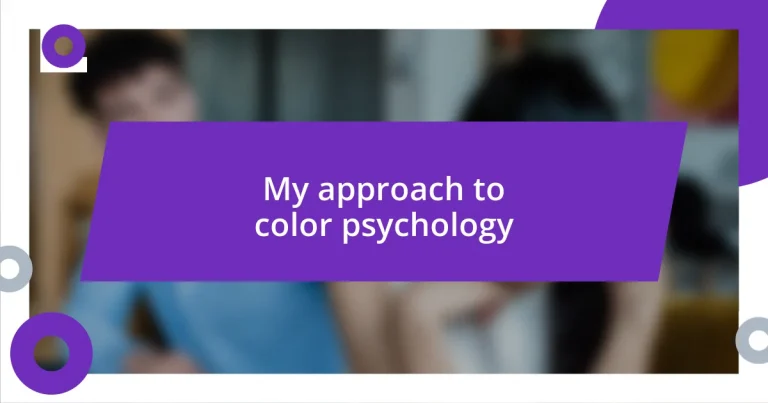Key takeaways:
- Colors significantly influence emotions and behaviors, with different hues evoking distinct feelings, such as red for energy and blue for calmness.
- Mindful color choices in personal spaces can transform moods, enhance social gatherings, and create comforting environments that promote well-being.
- Experimenting with color combinations and personalizing palettes can lead to unexpected improvements in emotional experiences and overall ambiance in various settings.
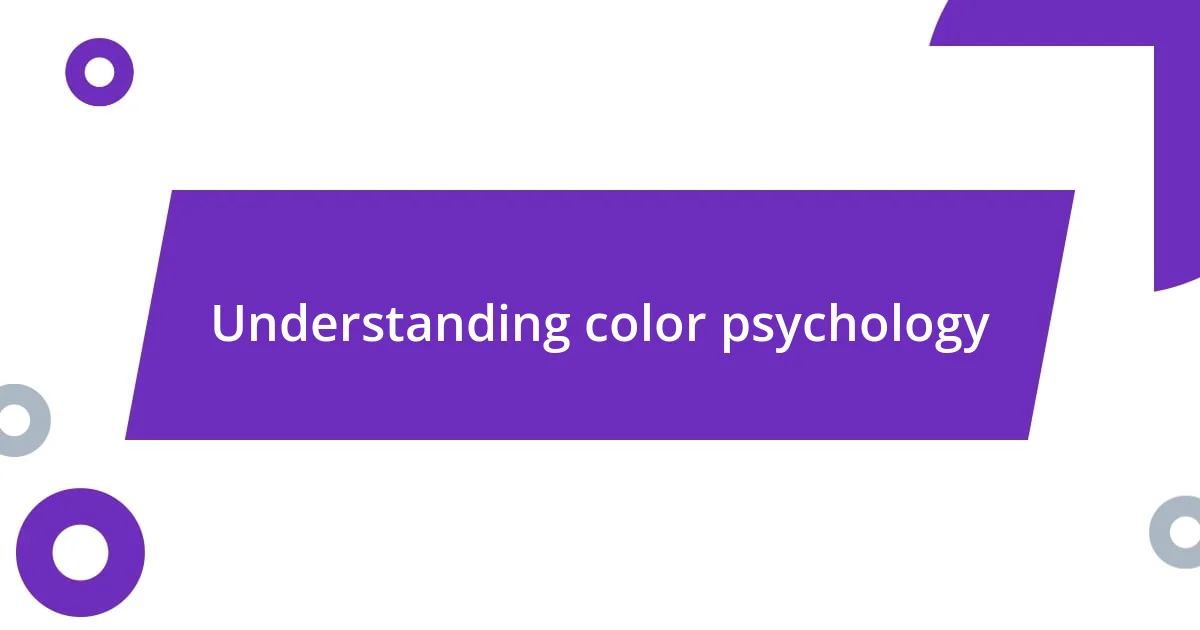
Understanding color psychology
Color psychology is such a fascinating field that dives deep into how colors influence our thoughts, feelings, and even behaviors. One time, I painted my home office a soothing blue, and it transformed my work experience. Suddenly, I felt more focused and creative—proof that the right color can set the perfect mood.
Have you ever noticed how certain colors affect your emotions? For instance, the vibrant hue of red can evoke feelings of passion and urgency, while soft pastels often bring about calmness and comfort. I love incorporating warm colors in my living space because they create an inviting and energetic atmosphere that’s perfect for gathering with friends.
It’s interesting to think about how colors can sometimes trigger memories or emotions we didn’t even realize were connected. I recall walking into a room painted in a lush green, and it transported me back to my grandmother’s garden, filled with blooming flowers and childhood laughter. Isn’t it compelling how color can serve as a bridge to our most cherished memories?
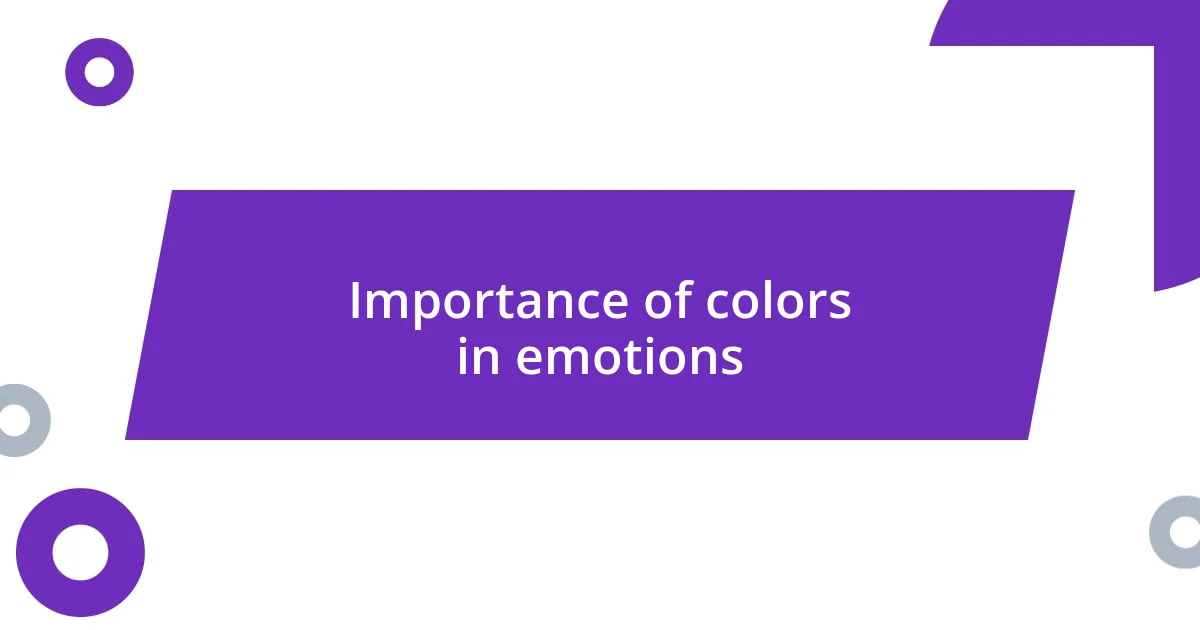
Importance of colors in emotions
Colors play a pivotal role in shaping our emotions and psychological states. I remember attending a wedding where the venue was drenched in golden hues. It was as if the atmosphere hummed with joy and optimism, instantly lifting everyone’s spirits. In contrast, I’ve also experienced spaces dominated by grays that felt oppressive; you could almost sense the collective melancholy hanging in the air.
Here are some examples of how colors can influence emotions:
- Red: Stimulates energy, passion, and urgency.
- Blue: Promotes calmness, focus, and creativity.
- Yellow: Evokes happiness, positivity, and warmth.
- Purple: Inspires creativity, luxury, and introspection.
- Green: Fosters healing, balance, and connection to nature.
Understanding these connections can help us curate our environments to enhance our emotional experiences.

Common colors and their meanings
It’s intriguing how common colors can have distinct meanings that resonate deeply with us. For example, I remember a time I visited a café painted in soft yellow. The ambiance felt so uplifting, sparking joy as I sipped my coffee. Yellow often symbolizes happiness and positivity, making it perfect for spaces meant for social interaction.
When it comes to blue, I have a special connection. A friend of mine painted her bedroom a serene shade of blue, and walking in felt like a breath of fresh air. Blue often embodies calmness and tranquility, which explains why I seek it out when I need to unwind. It’s fascinating how some hues can act like a comforting embrace, influencing our mood just by being present in our environments.
Green stands out for me too. I recently worked from a co-working space adorned in rich green tones, and I felt recharged and grounded. Green symbolizes balance and healing—qualities I cherish especially during busy workdays. It’s remarkable how mindful choices in color can transform not only our spaces but also our emotional states.
| Color | Meaning |
|---|---|
| Red | Energy, passion, urgency |
| Blue | Calmness, focus, creativity |
| Yellow | Happiness, positivity, warmth |
| Purple | Creativity, luxury, introspection |
| Green | Healing, balance, connection to nature |
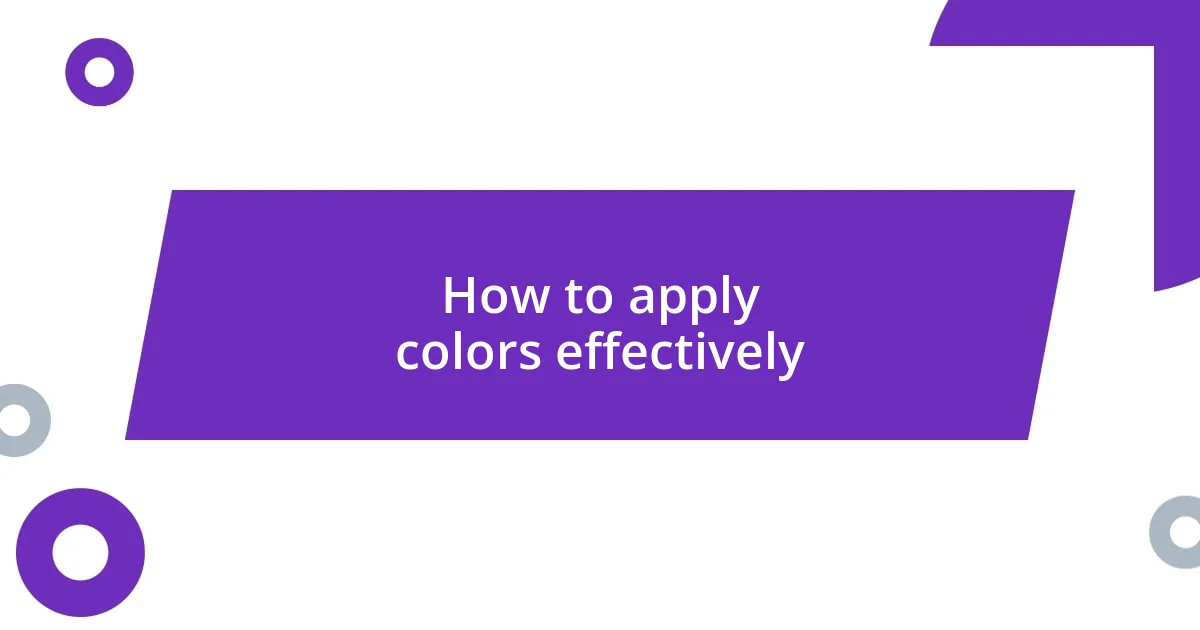
How to apply colors effectively
Utilizing colors effectively is about more than just aesthetics; it’s about how they make us feel. I recall when I decided to paint my home office a crisp white. The first time I walked in after it was completed, I was surprised by how the brightness instantly inspired me to tackle my tasks. Isn’t it fascinating how a simple color choice can elevate your mood and motivation in an instant?
When focusing on color application, I often ask myself how the hues in my environment affect my daily experiences. For example, I once transformed a dull corner of my living room by adding a vibrant orange throw blanket. The energy in that space shifted dramatically, becoming more inviting and lively. This taught me that vibrant colors can easily enhance social spaces, making gatherings feel more joyful and exciting.
Additionally, I’ve experimented with softer hues in my bedroom, opting for gentle pastels. Each night when I settle into bed, the calming effect of my lavender walls wraps around me like a soft cloud, soothing my thoughts. How many of us could benefit from such nurturing environments? Making mindful choices in color can truly foster serenity and rejuvenation, which I think is essential for our well-being.
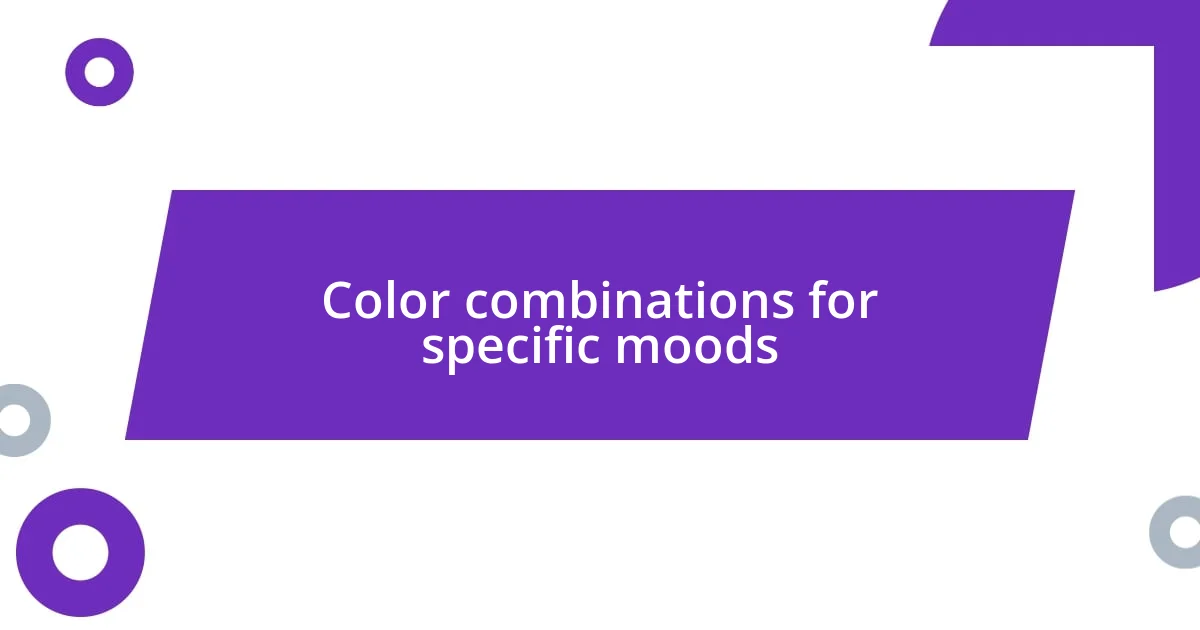
Color combinations for specific moods
Pairing color combinations thoughtfully can create powerful moods and enhance our experiences. I vividly recall hosting a dinner party where I used deep red table settings alongside gold accents. The combination radiated warmth and excitement, making everyone feel energized as we shared stories and laughter. Isn’t it amazing how such colors can effortlessly set the tone for a gathering?
When I decided to design my fitness space at home, I leaned into blue and green tones. The blend of calming blue walls and vibrant green decor created a refreshing atmosphere that pushed me to stay motivated during workouts. Every session felt invigorating, turning what could’ve been a mundane routine into a revitalizing experience. Have you ever thought about how your workout environment could influence your performance?
I also find that earthy tones like browns and soft oranges evoke a cozy, nurturing mood. After incorporating these colors into my reading nook, it became my favorite escape from the hectic day. Curling up with a good book in that inviting space wraps me in comfort, which makes it easy to unwind. How often do we overlook the simple yet profound impact color combinations can have on creating our personal sanctuaries?
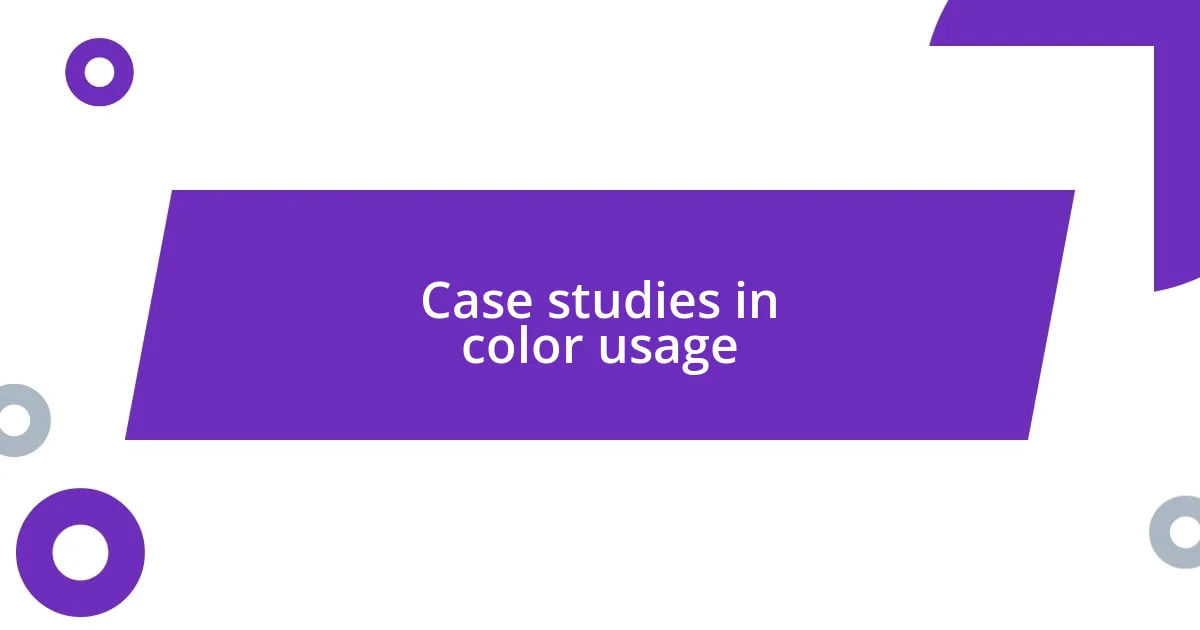
Case studies in color usage
One of my favorite experiences with color usage comes from a visit to a local bakery. The interior was painted in cheerful yellows and soft pastel pinks, creating a joyful ambiance that made it hard not to smile. As I enjoyed my coffee, I couldn’t help but wonder how much that vibrant atmosphere contributes to the overall experience, encouraging patrons to linger longer and indulge more.
When I painted my kitchen a bright, sunny yellow, the transformation was remarkable. Cooking became a more enjoyable experience, and even meal prep felt like a joyful occasion instead of a chore. I remember the first time my friends came over for dinner; they remarked on how warm and inviting the space felt. Isn’t it interesting how specific colors can turn a mundane routine into something lively and engaging?
In stark contrast, I once visited a dental clinic decorated in cold blues and whites. Instead of a calming effect, it felt sterile and a bit intimidating. I left questioning whether my anxiety about dental appointments was partly due to that emotionally distant environment. It made me realize that not all color choices positively impact perceptions and comfort levels. How often do we ignore the psychological effects of colors in places we frequent?
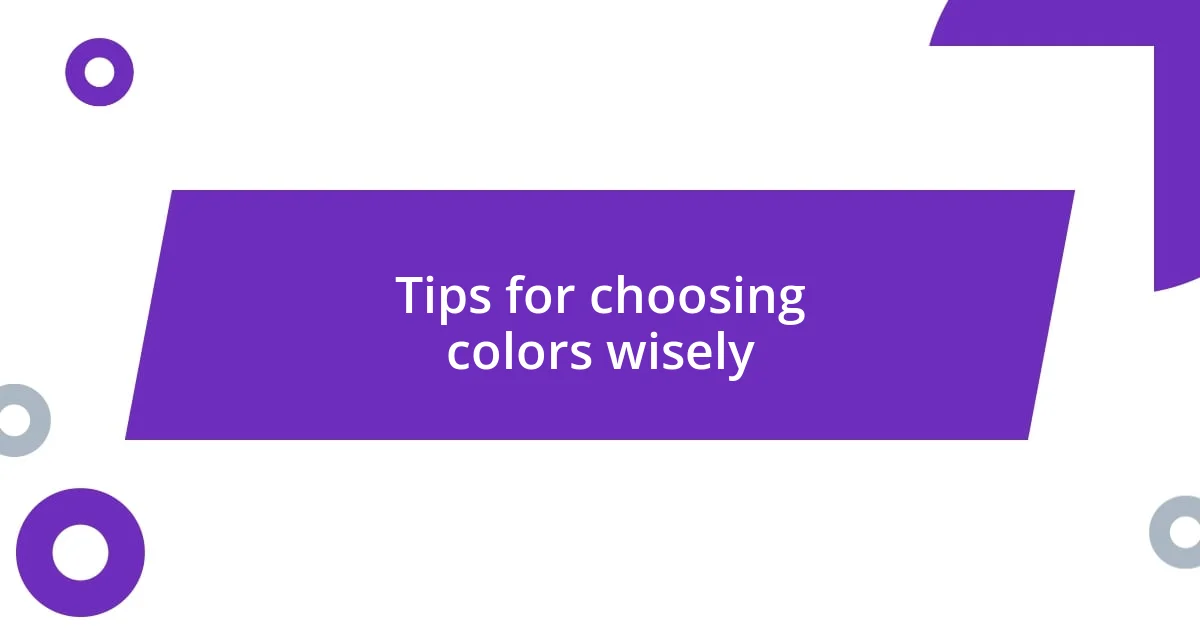
Tips for choosing colors wisely
When choosing colors, consider the emotions you want to evoke in a space. I remember painting my workspace a soft lavender, thinking it would spark creativity. The result was surprising: I felt more relaxed and focused, leading to deeper brainstorm sessions. Have you ever experimented with a color and found it altered your mindset in unexpected ways?
Another tip is to test colors in varying lights. On a whim, I painted one room a bold teal under natural daylight, and it felt vibrant and alive. However, when the sunset light filtered in, the same color transformed into a moody, almost somber tone. It was a reminder that the best color decisions often require patience and a little trial and error.
Don’t shy away from incorporating personal elements into your color palette. I once added splashes of teal to a friend’s home because it reminded her of her childhood beach vacations. Those little touches turned her living room into a nostalgic oasis, bringing joy every time she walked in. Have you thought about how your favorite memories could inspire your color choices?












